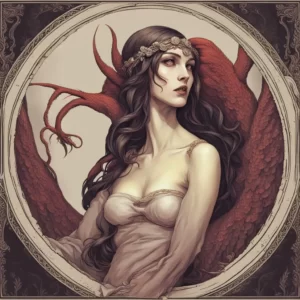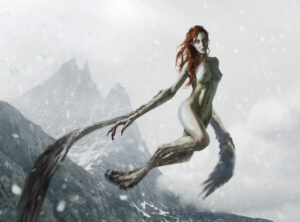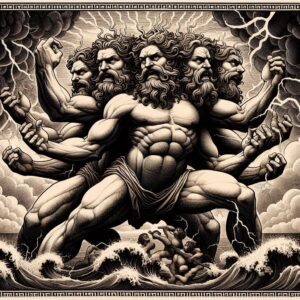Table of Contents
Lilith is known to be the first wife of Adam that turns evil. This however is a belief that derives from the Middle Ages. The original Lilith is stated as a Demon that kills children during pregnancy and childbirth.
Originally Lilith was a Demon in Babylonian mythology where she would prey on infants and pregnant women. Amulets and incantations were evoked to combat the evil Lilith. The belief of Lilith migrated to the Greeks, Egyptians, Israelites and Hittites. Lilith is mentioned in the Bible as being a wild Demon that is shunned by the prophet Isaiah. In the Middle Ages, she reappears as the first wife of Adam.
The name ‘Lilith’ derives from the Sumerian word for female Demons or wind spirits. The ‘lilitu’ and ‘ardat lili’. They live in the desert lands and open country spaces and are especially dangerous to pregnant women and infants. Her breasts are filled with poison she is furious with infertile women who act aggressively towards young men.
It was tradition in to have a plaque hung above the house of a pregnant woman. This plaque would ward off the evil spirit. It was believed that is Lilith came and read her name she would run in fear. Such amulets helped people cope with the fear of miscarriage. On tablet found in Syria in 1933 that dates back to the 8th reads:
“O you who fly in (the) darkened room(s),
Be off with you this instant, this instant, Lilith.
Thief, breaker of bones.”

Lilith is first mentioned in the epic of Gilgamesh an ancient Sumerian tale from 2,000 BCE. When the heavens and the earth separate, humans are created. Meanwhile Inanna, the goddess of erotic love and war, is taking willow from a huluppu tree, so that she can use the wood to build a throne. The tree is suddenly overcome with villains, one of which is Lilith.
“Inanna, to her chagrin, found herself unable to realize her hopes. For in the meantime a dragon had set up its nest at the base of the tree, the Zu-bird had placed his young in its crown, and in its midst the demoness Lilith had built her house.”
Gilgamesh rushes to save Inanna wearing heavy armour and brandishing sharp weapons. Gilgamesh kills the Dragon at the base of the tree at which the Zu-bird flees to the mountains and Lilith runs in fear.
There is a brief mention of Lilith in the Bible. In the Book of Isaiah, the prophet discourages the worship of foreign deities particularly the beliefs of the Edomites. It is said that the land of Edom was a wilderness of chaos and infertile soil. There too the Lilith lived as Lilith was banished by Gilgamesh to live in such unruly lonely deserts. Lilith is thus briefly mentioned in the Book of Isaiah with the assumption that Lilith was well known to the reader.
“Wildcats shall meet hyenas,
Goat-demons shall greet each other;
There too the lilith shall repose
And find herself a resting place”
(Isaiah 34:14)
Other mentions of Lilith are found in the Dead Sea Scrolls and Talmud which indicate that the rabbis knew of her existence (around 600 CE). Here at this time, she remains the same in character. However a more elaborate interpretation of there is created in The Alphabet of Ben Sira a document about tales of Ben Sira of which each chapter represents a letter of the alphabet. In one chapter, Ben Sira is called to save a kings daughter. Ben Sira then evokes the powers of 3 angels who fly out to destroy interfering spirits and Demons such as Lilith. It is said that Lilith is found in the Red Sea. It also details that Lilith was the first woman created by god. Adam and Lilith argued, Adam believing he was superior and Lilith stating that she is equal because both cam from the earth. (note that the name Adam in Hebrew derives from the word ‘adamah’ meaning earth.) Lilith then utters the name of the Lord God a name so holy it should not be uttered. With this and her arguments she is banished from paradise and will kill many children thereafter.
Special Abilities:

Seduction and Allure: She is often associated with seductive qualities, using her charm and allure to entice individuals.
Rebellion and Independence: One of her notable traits is her rebellion against authority, particularly in the context of rejecting subservience to Adam.
Supernatural Powers: Depending on the myth, Lilith may possess various supernatural abilities, such as shape-shifting, flight, and other magical powers.
Fertility and Motherhood: In some traditions, she is also connected to fertility and motherhood, though not always in a positive light.
Explanation of the Myth:
The Lilith myth has its roots in various cultures and religious traditions:
Hebrew Tradition: She is sometimes considered Adam’s first wife in Jewish folklore. She rebels against Adam’s authority, leaves the Garden of Eden, and becomes a mother of demons.
Mesopotamian Mythology: Lilith-like figures appear in Mesopotamian mythology as demons or spirits that bring harm, particularly to pregnant women and infants.
In Modern Usage and Symbolism:
Feminist Symbol: sometimes embraced as a feminist symbol representing female autonomy, independence, and the rejection of oppressive gender roles.
Sexuality and Freedom: In modern contexts, Lilith can symbolize sexual liberation and the pursuit of personal freedom, reflecting themes of empowerment.
Art and Literature: Lilith often appears in literature, art, and music, where creators draw upon her symbolism to explore themes of rebellion, desire, and the darker aspects of femininity.
Related and Similar Creatures:
Succubi and Incubi: These are supernatural entities often associated with seduction and sexual activity in folklore, akin to Lilith’s seductive qualities.
Night Hags: Found in various cultures, night hags or witches are supernatural beings associated with malevolent activities, sometimes similar to Lilith’s darker aspects.
Lamia: In Greek mythology, Lamia is a female demon or monster associated with devouring children. Similar themes of harm to infants connect Lamia to certain Lilith myths.
Lilim: In some traditions, she is said to give birth to demonic offspring known as Lilim, further expanding the supernatural elements associated with her myth.
It’s crucial to recognize that interpretations of Lilith and related beings can vary widely, and these creatures often serve as rich symbols that evolve over time and across different cultural contexts.




